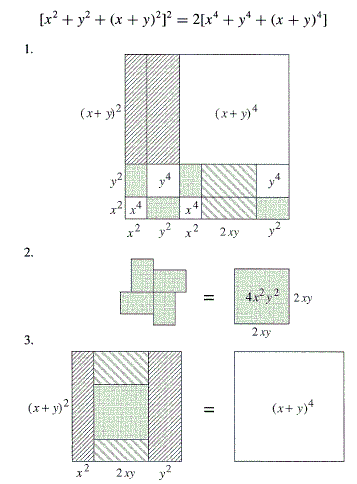Candido's Identity
Giacomo Candido (1871-1941) has invented a formula that seems to have been published posthumously ten years after his death:
\((x^{2}+y^{2}+(x+y)^{2})^{2}=2(x^{4}+y^{4}+(x+y)^{4})\).
The formula can be easily verified by carrying through the operations involved. There is also a proof without words by Alsina and Nelsen:

Candido applied the formula to establishing a property of the Fibonacci numbers:
\((F_{n-1}^{2}+F_{n}^{2}+F_{n+1}^{2})^{2}=2(F_{n-1}^{4}+F_{n}^{4}+F_{n+1}^{4})\).
The formula is little known - I found it mentioned only in a recent book by R. Grimaldi.
Alsina and Nelsen generalized the question by asking for solutions \(f\) of the functional equation
\(f(f(x) + f(y) + f(x + y)) = 2 [f(f(x)) + f(f(y)) + f(f(x + y))].\)
They proved that, assuming \(f\) is continuous function from \([0,\infty)\) onto \([0,\infty)\) such that \(f(0) = 0\), the solution is unique (up to a constant factor), \(f(x)=x^2\). There are really great many discontinuous solutions. Any \(f\) with the property that \(f(x) =0\) for rational \(x\) and \(f(x)\) rational (but arbitrary!), otherwise, satisfies the generalized equation!
R. S. Melham extended the property of the Fibonacci numbers by showing (among others) that
\(2(F_{n}^{2}+F_{n+1}^{2}+F_{n+2}^{2}+F_{n+3}^{2})^{2}=3(F_{n}^{4}+F_{n+1}^{4}+F_{n+2}^{4}+F_{n+3}^{4})^{4}\).
References
- C. Alsina, R. B. Nelsen, Candido's Identity, Mathematics Magazine, Vol. 78, No. 2 (Apr., 2005), p. 131
- C. Alsina, R. B. Nelsen, On Candido's Identity, Mathematics Magazine, Vol. 80, No. 3 (Jun., 2007), pp. 226-228
- G. Candido, A Relationship Between the Fourth Powers of the Terms of the Fibonacci Series, Scripta Mathematica, 17:3-4 (1951) 230
- R. Grimaldi, Fibonacci and Catalan Numbers: an Introduction, Wiley, 2012
- R. S. Melham, YE OLDE FIBONACCI CURIOSITY SHOPPE REVISITED, Fibonacci Quarterly, 2004, 2, 155-160
Fibonacci Numbers
- Ceva's Theorem: A Matter of Appreciation
- When the Counting Gets Tough, the Tough Count on Mathematics
- I. Sharygin's Problem of Criminal Ministers
- Single Pile Games
- Take-Away Games
- Number 8 Is Interesting
- Curry's Paradox
- A Problem in Checker-Jumping
- Fibonacci's Quickies
- Fibonacci Numbers in Equilateral Triangle
- Binet's Formula by Inducion
- Binet's Formula via Generating Functions
- Generating Functions from Recurrences
- Cassini's Identity
- Fibonacci Idendtities with Matrices
- GCD of Fibonacci Numbers
- Binet's Formula with Cosines
- Lame's Theorem - First Application of Fibonacci Numbers
|Contact| |Front page| |Contents| |Algebra|
Copyright © 1996-2018 Alexander Bogomolny73514618
